Catching up with a summer issue of the New York Review of Books, I was enthralled by Michael Pollan’s article ‘The Food Movement, Rising’ about the new food movement(s) and the intersection with business, government and society. The article is worth reading in itself, but it was one particular quote, from Janet Flammang’s new book, The Taste for Civilization: Food, Politics, and Civil Society, that struck me most:
“Food is apprehended through the sense of touch, smell and taste, which rank lower on the hierarchy of sense than sight and hearing, which are typically thought to give rise to knowledge.”
Flammang’s book is, of course, about much more than how we experience food, but I am intrigued by the sensory notion she touches on. Of course, Aristotle’s classical hierarchy of the senses is widely accepted (in order: sight, hearing, smell, taste and touch) but the idea that really only two of our ‘big five’ and our estimated total 9-21 senses are considered on the path to knowledge and reason is peculiar. With so many senses at our disposal, we have historically relied on only sight and hearing to advance our minds.
Based on Fleming’s VARK Model, much of education divides pupils into visual learners or audible learners, based on an increased ability to understand through sight or hearing, respectively. Fleming’s Model also highlights two other types of learning styles: reading/writing-preference learners and kinesthetic (tactile) learners, where the latter relies on touching, moving and doing activities. I am intrigued, however, that despite widely accepted models of various learning styles, the number of senses involved in traditional education is limited. There would seem to be huge untapped potential in thinking more holistically about involving all our senses, perhaps by first limiting some to heighten others and see what happens.
At present, there are very few fields of education, or indeed, jobs that rely more on senses other than sight and hearing. Training to become a chef or a sommelier are perhaps the most obvious, where taste and smell are paramount, followed by sight (I’ve not heard of any sommeliers listening to how a wine pours or sips, but you never know…). And there we return to Flammang’s argument – the sense of smell, touch and taste are generally perceived to be ‘of the body’ and the body tends to symbolise our animal tendencies. Sight and hearing are considered above bodily senses because they represent our ability as civilised beings to be ‘of the mind’.
Those without sight and/or hearing have found countless of ways to understand and grasp concepts and the world around them. Braille relies on the sense of touch in lieu of sight and sign language relies on sight in lieu of hearing, but there must be more than just these… Surely we haven’t unearthed all ways of communicating and learning to date? What if a newly conceived version of Braille didn’t just allow the blind to read words and language, but it displayed entire concepts through sensory maps and diagrams?
So what if Aristotle was wrong? (Oh no, did I really just say that?) What if our other senses haven’t played a bigger role in advancing our wisdom not because they really rank lower than sight and hearing, but because we haven’t placed as much emphasis and value on using them? We know that sensory deprivation of one sense can lead to a heightened awareness and understanding through the other senses, so what would happen if we put more effort into using our sense of smell, taste, touch, time, balance, temperature, et al and learning through them?
It would seem that there is a huge opportunity here for an intersection between design, which already relies heavily on an increased understanding of all the senses, education, biology, psychology and a number of other fields. By just thinking about how we could design new ways of learning a range of subjects and concepts through senses other than just sight and hearing, we will open up a range of possibilities for greater human understanding and wisdom.
I personally have done some design work on translating visual concepts into tangible, tactile ones, but I want to go further. Can we learn philosophy through smell? Can we learn a language through touch? Can we learn mathematics through balance? Perhaps not, but I think there is something there… For example, it doesn’t seem so revolutionary to think that we might be able to learn geometry through touch, biology though temperature, or even geography through direction…

Be the first to write a comment
Comments
Please login to post a comment or reply
Don't have an account? Click here to register.